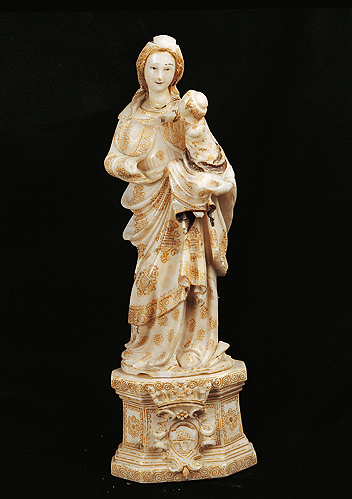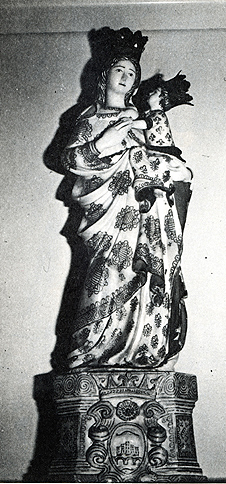The piece of the month of August 2007
VIRGIN OF TRAPANI: SURVIVAL OF A GOTHIC MODEL
Santiaga Hidalgo Sánchez
Chair de Patrimonio y Arte Navarro
This beautiful image of the Virgin and Child, which is currently kept in the Museum of Navarre, comes from the convent of Sancti Spiritus in Puente la Reina, where it was kept until it was acquired in the 1920s by the Commission of Historical and Artistic Monuments of Navarre. It is an alabaster sculpture, which still conserves the gold polychromy of the clothes and traces of colour on the faces and hair. Its size is 45 cm, of which 11 cm correspond to the pedestal, although we must suppose that its height would have been increased by the Virgin's crown, which has now disappeared, as well as that of the Child. The figure of Mary is holding the Child on her left arm, with a hint of a smile, while the Child, completely facing the viewer from profile , is looking at the Mother and his little hand is on her breast. Although the Virgin's right hand has been lost, we can assume, by comparison with other examples that we will present later, that she is caressing Jesus' left hand with it.

Photo 1. Anonymous copy of the Madonna di Trapani. Museum of Navarre.
Photo: Larrión and Pimoulier.
As Julia Ara Gil has already pointed out, this statue is a copy of the famous Madonna di Trapani. This image, which is venerated in the Carmelite church of l'Annunziata in the Sicilian city of the same name, has been widely debated in art historiography, particularly with regard to its author, topic . Various authorships have been proposed, the most widespread being perhaps the attribution to Nino Pisano, or a follower of his, at a date around 1350. This theory coincides with registration which, according to a 16th-century author, could be read on the Virgin's mantle, which dated the image to 1352 and indicated that it had been commissioned by a priest from Endithet, a city in Cyprus.
Our piece is yet another example of the wide dissemination of this iconography. Its cult was promoted above all by the Carmelite order - copies of the Madonna di Trapani often appear under the title of Our Lady of Mount Carmel, both being highly venerated by sailors - and from the 15th century onwards the sanctuary became a place of pilgrimage. In the same century, interpretations of the Gothic image were made by well-known Renaissance authors such as Francesco Laurana and Domenico Gagini. Throughout the 16th century and especially in the 17th century, the rise of devotion to the Madonna di Trapani led to a new wave of copies, although these were different in character from those of the 15th and early 16th centuries. The first difference is that during the 15th century "interpretations" of the image were made, with the introduction of attributes, stylistic and iconographic changes, etc.; on the other hand, from the end of the 15th century and throughout the 16th and 17th centuries, true copies of the original were made in workshops where production could almost be described as "mass-produced". Another difference is that the copies of the second period are between one metre and 40 cm, making them much smaller than the original and its sequels of the first period, which were life-size. This change in size is related to a change in function, as the copies from the first period were intended to be altar figures, while the second period copies were intended for devotional use in private oratories or convents. Furthermore, in the latter, the artistic quality and materials were reduced in order to reduce costs, as these figures were intended for sale and export. As we have noted, we know that in Trapani and elsewhere there were numerous workshops where these "serial" copies of the Madonna were made, and at one point in the Modern Age there were around 40 such workshops for alabaster pieces alone.

Photo 2. Pedestal of the anonymous copy of the Madonna di Trapani. Museum of Navarre. Photo: Larrión and Pimoulier.
The image in the Museum of Navarre comes from one of these Sicilian workshops. We know this from the coat of arms of the city of Trapani on the pedestal, which had previously been interpreted as that of Puente la Reina. The confusion is understandable, if we bear in mind that the statue was kept in a convent in this town, and that both coats of arms have elements in common. Indeed, the coat of arms of the Navarrese town has a canting bridge with three crenellated towers. Likewise, that of the Sicilian town has a bridge - although in this case straight and with the last arch unfinished - five crenellated towers, also crenellated, and above it a sickle, which makes reference letter to the Greek name - Drepanon means sickle - and to the mythical origin of this town. All these elements are present in the coat of arms carved on the pedestal of the image preserved in Navarre.
Thanks to the coat of arms, we can also propose a date of production for this piece. However, given that the statue of the Virgin and Child is a faithful copy of the 13th-century model , and that these were widespread from the 15th century onwards, we could accept the date of the first half of the 16th century suggested by some authors. However, as suggested by Ángela Franco, the style of the coat of arms pushes back the date of execution by a century. We are therefore looking at a piece made in the 17th century, a date that coincides with that of another copy of the Madonna di Trapani, kept in the convent of the Benedictines in Toledo, which is very similar to our image - the drawings in gold, the coat of arms subject - although better preserved.

Photo 3. Anonymous copy of the Madonna di Trapani. Monastery of RR. Benitas de Toledo. Photo: B. Martínez Caviró.
This is just one example of the wide diffusion that the copies of the statue of the Trecentista period had in our country. They are scattered all over Spain, along the coast and inland - although it is true that they are most commonly found in the Mediterranean area - in convents, private oratories and churches. Neither the political status - Spanish occupation of Sicily - nor the action of the Carmelite order, but above all the devotion aroused by the tenderness of the gestures and the formal beauty of the image, so close to the popular sensibility, are unrelated to the expansion of her cult, and therefore of her iconography. This diffusion, together with the fact that the works from the Trapani workshops were "serial" pieces intended for sale and export, makes it difficult to establish how the image reached the convent of Sancti Spiritu de Puente la Reina. We can assume - albeit with reservations, as we do not have any historical data - that it was a donation from a prominent local personage - perhaps a member of the house of Sarría - as is the case with other similar pieces of which more have been preserved data: the Virgin of the Bona Sort, from Vic, which was brought from Genoa for the Lord of Casa Brossa, who donated it to the nuns who today guard it; or the image dedicated to Our Lady of Trepana, donated to the monastery of the Encarnación de Osuna by the founding duchess.
bibliography
ARA GIL, C.J., Escultura gótica en Valladolid y su provincia, Valladolid, 1977.
FARIÑAS WINDELL, M.L., "La Santísima Virgen y el arte religioso", bulletin de la Comisión de Monumentos de Navarra, 1927, p. 275.
FRANCO MATA, A., "La Madonna di Trapani y su rep ercusión en España",bulletin del seminar del de programs of study de Arte y Arqueología de Valladolid, 64, 1983, pp. 267-286.
FRANCO MATA, A., "Three copies of the Madonna di Trapani in the Camón Aznar Museum of Zaragoza", bulletin del Museo e Instituto "Camón Aznar",24, 1986, pp. 5-32.
KRUFT, H.-W., "Die Madonna von Trapani und ihre Kopien. Studien zur Madonnen. Typologie und zum Begriff der Kopie in der sizilianischen Skulptur des Quattrocento," Mitteilungen des Kunsthistorischen Instituts in Florenz, 14, 1969-70, pp. 297-322.
SIDDI, L., "Le copie della Madonna di Trapani in Sardegna", in El món urbà a la Corona d'Aragó del 1137 als decrets de nova planta (XVII Congrès de Història de la Corona d'Aragó), vol. 2, Barcelona, 2003, pp. 421-431.
